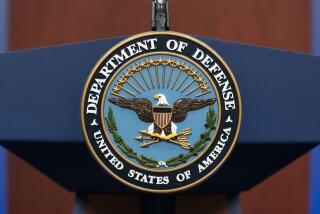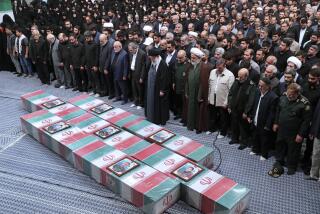U.S. Prepares for Strikes on Iraqi Targets : Persian Gulf: Air, missile attacks could be ordered if Baghdad fails to meet U.N. deadline on arms destruction.
- Share via
WASHINGTON — U.S. military officials are planning a series of air and missile attacks against Iraqi weapons sites if Baghdad does not comply with United Nations resolutions requiring it to destroy its remaining nuclear, chemical and ballistic missile facilities.
President Bush already has made “a philosophical decision” to order the military action if Iraqi President Saddam Hussein refuses to abide by terms of the cease-fire that ended the Persian Gulf War a year ago, Administration sources said Wednesday.
Bush would not give any order to execute the strikes until after March 26, the deadline for Baghdad to comply with the U.N. cease-fire resolutions. The President would seek U.N. approval for limited strikes, officials said. Some Administration officials said they expect Hussein to back down at the last minute to avoid punitive action, as he has on several other occasions.
The Pentagon, however, has drawn up detailed plans for an attack on Iraq, using aircraft based in Saudi Arabia and Turkey, including F-117 fighter-bombers; warplanes launched from the carrier America, which sailed into the Persian Gulf late last week, and cruise missiles fired from the cruiser Normandy, part of the carrier battle group.
A knowledgeable Pentagon official said that no ground troops would be involved in the strikes, reflecting the view of Gen. Colin L. Powell, chairman of the Joint Chiefs of Staff, who believes that it would take months to assemble a credible ground force for renewed action in Iraq.
The strikes would be limited, at least at first, to military facilities identified by U.N. inspection teams. “They will not hit too many sites. They don’t want to kill too many civilians,” the official said, describing the military planning as “advanced.”
The targets would be chiefly the nuclear weapons research complex at Al Atheer, south of Baghdad, and an estimated 14 sites where Scud missiles are manufactured or stored. All the sites have been visited by U.N. inspectors, and Pentagon planners have detailed floor plans, photographs and videotapes of the facilities, officials indicated.
Officials at both the White House and the Pentagon said Wednesday that they were “frustrated” because Hussein has repeatedly thwarted the U.N. resolutions but given no clear pretext for military action.
After Iraq’s defeat by allied forces last year, Baghdad agreed to a number of U.N.-sponsored cease-fire resolutions that required it to destroy its weapons of mass destruction--nuclear, biological and chemical--as well as its ballistic missile stockpiles and production facilities. In addition, Baghdad was forced to submit to inspections by teams of U.N. officials to document that the destruction program was being carried out.
The White House policy appears to be to await Hussein’s response to the U.N. deadline for presenting a detailed plan for destroying Iraqi missile production equipment and facilities. If he does not comply, officials said, Bush is ready to seek U.N. approval for limited air and missile strikes against the weapons sites.
An Administration source sounded a note of frustration, however, saying that senior advisers to Bush expect Hussein to back down before military action could be justified.
More to Read
Sign up for Essential California
The most important California stories and recommendations in your inbox every morning.
You may occasionally receive promotional content from the Los Angeles Times.










